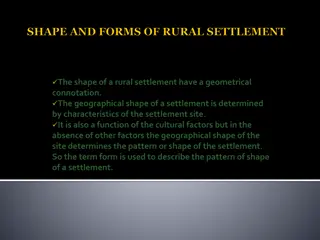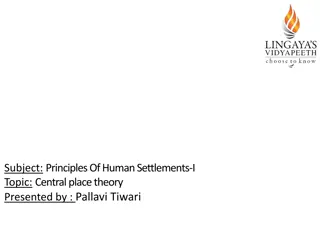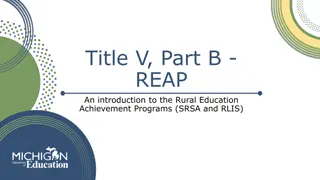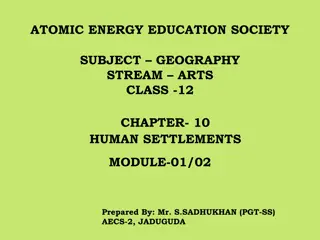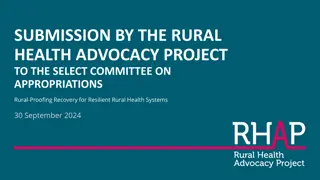Understanding Types of Rural Settlements in Geography
The classification of rural settlements varies based on location and structure. Authors like August Meitzen, Ahlman, R.B. Hall, Enayat Ahmad, and R.L. Singh have identified different types of rural settlements such as nucleated villages, isolated dwellings, compact villages, hamlets, and dispersed settlements. Functional classifications include farming villages, fisher villages, lumberjack villages, and pastoral villages. Each type serves specific purposes and reflects unique characteristics of rural areas.
Download Presentation

Please find below an Image/Link to download the presentation.
The content on the website is provided AS IS for your information and personal use only. It may not be sold, licensed, or shared on other websites without obtaining consent from the author. Download presentation by click this link. If you encounter any issues during the download, it is possible that the publisher has removed the file from their server.
E N D
Presentation Transcript
II M.SC. APPLIED GEOGRAPHY POPULATION AND SETTLEMENT GEOGRAPHY TOPIC : TYPES OF RURAL SETTLEMENT 21.8.2020 & 25.08.2020 Presented by S. MAHESWARI, GUEST LECTURER IN GEOGRAPHY, GCW(A)K
TYPES OF RURAL SETTLEMENT The classification of rural settlement has been approached in various ways. Settlements may be classified by many authors.They are August Meitzen (1895) He classified the rural settlements of Europe into two broad categories : 1.NucleatedVillage closely located together giving birth to a single large village. 2. Single Homestead or Isolated dwelling scattered widely taking different sites for their location. Ahlman (1928) He observed three forms of villages in Denmark : 1. The close or round village with farmstead enclosing a square or circle about an open space. 2.The long village with farmstead in two rows along a road. 3.The irregular village.
R.B.Hall (1913) He studing and classifieds the rural settlements forms in Japan has recognized four main types of rural settlements: 1.Compact village 2.The Satsuma type 3.Castles and walled village 4.The Echigo type R.E.Dickinson (1949) He studying the rural settlements of Germany, has recognized two extreme types of rural settlements : 1.Isolated farmstead 2.Nucleated village
Enayat Ahmad (1952) He recognized the following types of rural settlements in Uttar Prades(India): 1. Compact Settlements in which all the dwellings of a mauza (revenue village) are concentrated at one central site. 2. Cluster and Hamlet settlements in which besides a compact village, one or two hamlets are also situated away from the main village in a mauza. 3. Fragmented or Hamleted settlements this type consists of main village with several hamlets or fragments. 4. Dispersed settlements in which dwellings are not generally concentrated at one place but are isolated by some distance. R.L.Singh (1955) He has recognized four main types of rural settlements in Middle GangaValley: 1. Compact settlements 2. Semi-compact or hamleted clusters 3. Semi-sprinkled or fragmented or hamleted settlements 4. Sprinkled or dispersed type settlement.
FUNCTIONAL CLASSIFICATION OF RURAL SETTLEMENT There are four main types of functional classification of rural settlement. They are 1. Farming village 2. Firshering village 3. Lumberjack village 4. Pastoral village
FARMING VILLAGE It has been settled since the early 19th century,first as a farming village. This is mainly small scale farming village with farmers producing vegetables and fruits. wheat, barley, Its a typical farming village which contains 280 houses. But in 1940 the farming village had only 1239 residents. Originally a farming village,it has grown into an industrial center. This former farming village showed up about 1950,a steady population decline.
FISHERING VILLAGE A fishing village is a village, usually near a fishing economy based on catching fish and harvesting seafood. The continents and islands around the world have coastlines totalling around 356,000 km. From Neolithic time, these coastline, as well as the shorelines of inland lakes and the banks of rivers, have been punctuated with fishing villages. Most surviving fishing village are traditional. ground, with an
LUMBERJACKS VILLAGE Lumberjacks are mostly North American workers is the logging industry who perform the initial transport of trees for ultimate processing into forest products. harvesting and The term usually refers to a bygone era (before 1945 in U.S.) when hand tools were used in harvesting trees. Because of his historical ties, the term lumberjack has become ingrained in popular culture through folklore, spectator sports. mass media and The actual work was difficult, dangerous, intermittent, low-paying and primitive in living conditions.
PASTORAL VILLAGE Pastoral villages are residential regions whose primary land use in pasture for livestock. Pastured land regions is so intense that more than half of the regions in this anthrome use at least 66% of their land for pasture like other village anthromes, villages are largely located im Asia. use in these pastoral
CLASSIFICATION OF RURAL SETTLEMENT ON THE BASIS OF SHAPE There are four major type of rural settlements are as follows: 1. Dispersed Settlements, 2. Fragmented or Hamleted Settlements, 3. Semi-compact or Composite Settlements, and 4. Compact or Agglomerated Settlements.
DISPERSED SETTLEMENTS Dispersed settlement is also known as sprinkled settlement. Its characterized by complete diffusion of farmsteads or homesteads over the entire revenue village land. There is long distance between dwellings compared with the congestion or compactness of the settlements in fertile plains. These settlements are commonly found in the areas of unsuitable climates, mountainous and hilly areas, thick forests, agricultural lands with poor fertility, regions of extensive cultivation and the regions where it is essential or more fruitful that farmer should live on his farm rather than in a distant compact settlement. Actually the phenomena of dispersed settlements are not very old but they are relatively recent in age.
FRAGMENTED OR HAMLETED SETTLEMENTS This type of settlements consists of several hamlets of fragments. Sometimes,its difficult to recognize the main site of the village. The fragmented and hamleted terms are by Enayat Ahmad and R.L.Singh. In some revenue villages, population is a distributed throughout the land in some hamlets in which it is difficult to trace the main site. The number of hamlets vary generally from four to ten or more. The hamlets are separated by the presence of cultivated fields, low lands,garden,nala or even tracts of forest. Hamleted tendency is caused by the absence of insecurity and economic advantages. Every hamlet has its own agricultural and pasture fields.
SEMI-COMPACT OR COMPOSITE SETTLEMENTS This type of settlement is termed as cluster and hamlet settlement by EnayatAhmad. Other wise termed as Hamleted cluster by R.L.Singh. These settlements, beside a compact village, one or two hamlets are also situated away from the main village in a maiza. It is an intermediate type between the two extremes i.e., nucleated and dispersion. So this type of settlement is characterised by both types. Such semi-compact settlements are also known as composite settlements. Such settlement is marked by one main village with two to five or more hamlets having the population of 100 to 200 people. These hamlets are linked with the main site by the foot paths or bullock cart tracks. The creation of hamlets around an original nucleated settlement has often occurred in the past, often related with the process of reclamation of land for agriculture J.P.Misra.
COMPACT OR AGGLOMERATED SETTLEMENTS In compact settlement all the dwellings are agglomerated at one single site or entire population of a village is concentrated in one cluster. When the individual dwellings are grouped in a relatively small portion of occupied territory and number of dwelling varies from few dozen in small hamlets to thousand of houses in very large villages and exhibit a high degree of cohesion they produce agglomerations of varying shape and size A. Prasad. Compact settlement is the result of centripetal forces which are active in the village territory. Compact villages are found in the perennial river valleys and fertile track of agricultural land and such settlements have been mainly the characteristics of fertile plain since ancient times. Some attractive forces which have led to the origin of the compact villages are flat plains with fertile soils, sufficient rainfall, agglomeration of water point, a high water table, perennial river, need of cooperation, social, economic, and religious thoughts, crop pattern,rich forest and insecurity im the past.












